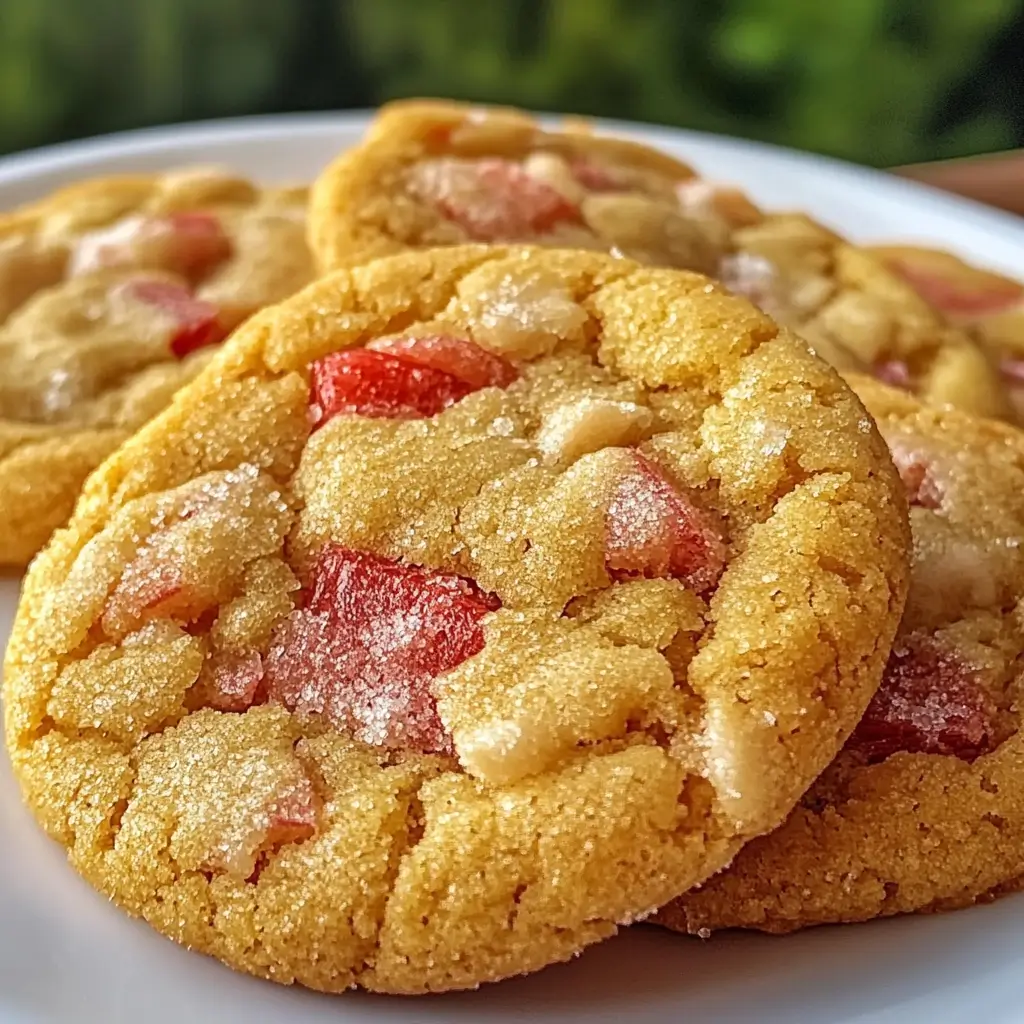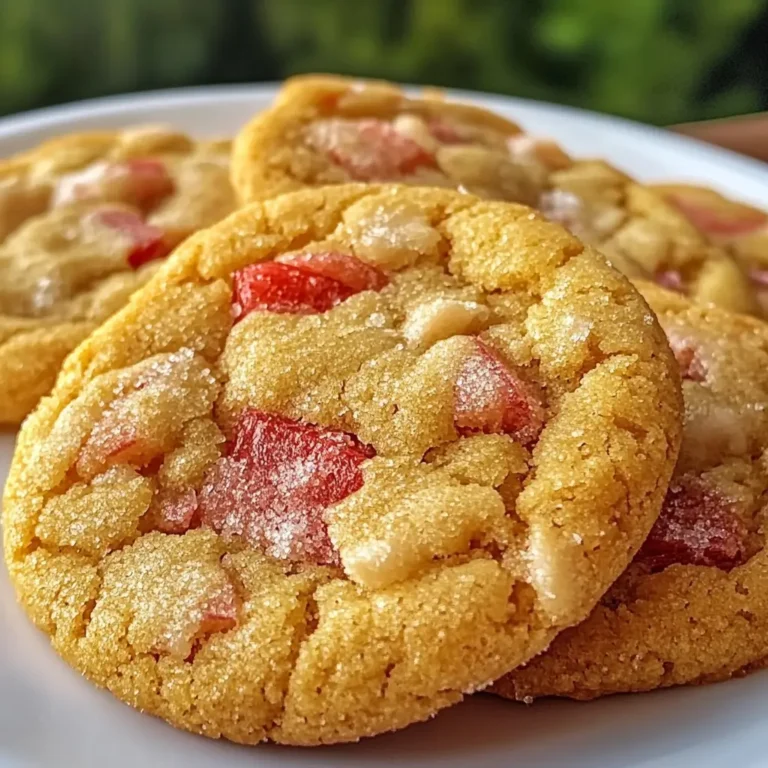Table of Contents
1. Introduction
Cookies are more than just a dessert; they’re often little bites of comfort, nostalgia, and seasonal joy. These Brown Sugar Rhubarb Cookies perfectly capture the essence of spring baking, celebrating the unique flavor of one of the season’s first abundant ingredients: rhubarb. While classic chocolate chip or peanut butter cookies hold a special place in our hearts, there’s something truly delightful about incorporating fresh, unexpected flavors into a familiar format.
This recipe takes a classic brown sugar cookie base – known for its soft, chewy texture and rich, molasses-like sweetness – and folds in finely diced rhubarb.1 As the cookies bake, the rhubarb softens, its vibrant tartness creating a beautiful counterpoint to the deep sweetness of the brown sugar. It’s a simple combination that yields surprisingly complex and utterly addictive results.
Rhubarb has long been used in pies, crumbles, and jams, often paired with strawberries to temper its sharpness.2 Using it in cookies is a more modern approach, allowing its distinct flavor to stand out in a delightful new way. These cookies are a testament to the versatility of this springtime stalk, proving that rhubarb can be just as charming in a handheld treat as it is in a pie, offering a delightful sweet-tart combination that is unexpectedly wonderful. Their chewy texture is reminiscent of other beloved cookie recipes.
2. Recipe Summary
Cuisine: American (Baking / Seasonal)
Difficulty Level: Easy
Total Preparation and Cooking Time: Approximately 27 minutes (plus optional chilling time)
Dietary Classification: Vegetarian (contains dairy, eggs, and gluten)
3. Equipment and Utensils
You’ll need standard baking equipment for these cookies:
- Baking sheets: You’ll likely need two baking sheets or need to bake in batches.
- Parchment paper: Lining the baking sheets prevents sticking and makes cleanup easy.3
- Medium bowl: To whisk together the dry ingredients (flour, baking soda, salt).
- Large mixing bowl: For creaming the butter and sugar and mixing the dough.
- Electric mixer (stand or hand-held): Highly recommended for creaming the butter and sugar until light and fluffy.
- Measuring cups and spoons: Accuracy is key in cookie baking.
- Dry measuring cups (1 ¾ cups, 1 cup, 1 cup): For flour, brown sugar, and diced rhubarb.
- Measuring spoons (½ tsp, 2 tsp): For baking soda, salt, and vanilla extract.
- Rubber spatula or wooden spoon: For mixing and folding ingredients.
- Sharp knife: For finely dicing the rhubarb.
- Cutting board: A stable surface for preparing the rhubarb.
- Paper towel: To pat the diced rhubarb dry.
- Cookie scoop (optional): A tablespoon-sized cookie scoop helps create uniform cookies that bake evenly.
- Wire rack: For cooling the baked cookies.
4. Serving Suggestions
Brown Sugar Rhubarb Cookies are wonderful on their own, but a few serving ideas can enhance their appeal.
- Plating: Arrange the cooled cookies on a plate or cooling rack. Their golden-brown edges and slightly pink interiors from the rhubarb are inviting.
- Side Dish Ideas: These are best enjoyed as a stand-alone treat. However, a glass of milk or a cup of tea or coffee is a perfect accompaniment.
- Complementary Side Dishes: For a cookie platter, consider including other springtime treats or classic favorites like fluffernutter cookies for variety.
- Wine or Beverage Pairings:
- Milk, coffee, or tea are classic and comforting pairings.
- For something a bit more sophisticated, a slightly sweet dessert wine like a late-harvest Riesling could complement the sweet and tart notes.
5. Nutritional Information
Please note that the following nutritional information is an estimate per cookie (based on 24 servings) and can vary based on the specific brands of ingredients used and the size of your cookie scoops.
Detailed Nutritional Breakdown (Estimate per cookie):
- Calories: Approx. 160 kcal
- Macronutrient Distribution (Estimate):
- Carbohydrates: 20-25g (primarily from flour, sugar, and rhubarb)
- Protein: 1-2g (from flour and egg)
- Fat: 7-9g (primarily from butter)
- Dietary Information: Vegetarian. Contains dairy, eggs, and gluten.4
- Potential Health Benefits: While a sweet treat, these cookies offer a bit of fiber from the rhubarb and some nutrients from the butter and egg. However, they are calorie-dense and high in sugar and fat, best enjoyed in moderation.
6. Storage
Proper storage keeps these cookies fresh and chewy.
- Proper Storage Instructions: Once completely cooled, store the cookies in an airtight container at room temperature. Placing a slice of bread in the container can help keep them soft.
- Refrigeration Instructions: For longer storage (more than a few days), you can refrigerate the cookies in an airtight container for up to a week. The texture may become slightly firmer when cold.
- Freezing Recommendations: Baked and cooled Brown Sugar Rhubarb Cookies freeze well. Place the cooled cookies in a single layer on a baking sheet and freeze until firm. Then, transfer to a freezer-safe airtight container or bag, placing parchment paper between layers to prevent sticking. Freeze for up to 2-3 months. Thaw at room temperature before serving. You can also freeze the raw dough (see Expert Tips).
- Reheating Methods: Cookies are typically enjoyed at room temperature. If you prefer them slightly warm, you can microwave a cookie for 10-15 seconds, but be careful not to overheat, which can make them hard.
7. Expert Tips and Variations
Master the art of baking these cookies with these tips and creative ideas.
- Tips from Professional Chefs:
- Use room temperature butter and egg: This is crucial for proper creaming and emulsification, resulting in a better cookie texture.
- Don’t overmix the dry ingredients: Mix just until combined to avoid developing too much gluten, which can lead to tough cookies.5
- Finely dice the rhubarb: Small pieces distribute better in the dough and soften nicely during baking.
- Pat the rhubarb dry: As noted in the recipe, patting the finely diced rhubarb with a paper towel helps remove excess moisture, which can affect the cookie’s texture and spread.
- Don’t overbake: Bake just until the edges are golden and the centers look slightly set. The cookies will continue to cook slightly as they cool on the pan, resulting in a soft, chewy interior.
- Chill the dough: For thicker, chewier cookies, chill the dough in the refrigerator for at least 30 minutes before scooping and baking, as suggested in the recipe tips. Chilling solidifies the fat, which helps the cookies spread less.6
- Common Mistakes to Avoid:
- Using cold butter: Leads to a less smooth dough and can affect spreading.
- Overmixing the dough after adding dry ingredients: Results in tough cookies.7
- Not patting the rhubarb dry: Can add too much moisture to the dough, leading to excessive spreading and a less desirable texture.
- Overbaking: Results in hard, dry cookies.
- Creative Recipe Variations:
- Add white chocolate chips: White chocolate pairs beautifully with rhubarb and brown sugar.8 Fold in ½ cup of white chocolate chips with the rhubarb.
- Add nuts: Chopped walnuts or pecans can add a nice crunch. Fold in ½ cup with the rhubarb.
- Spice it up: Add a pinch of ground ginger, nutmeg, or cardamom to the dry ingredients for extra warmth.
- Lemon zest: Add the zest of one lemon to the wet ingredients for a brighter citrus note that complements the rhubarb.
- Different sugar: A mix of brown sugar and granulated sugar can be used, but the texture will be slightly different (more spread with more granulated sugar).
- Freeze the dough: You can scoop the dough into balls and freeze them on a baking sheet until firm.9 Then, transfer the frozen dough balls to a freezer-safe bag or container. Bake from frozen, adding a couple of extra minutes to the baking time. Freezing dough is a great way to have fresh cookies anytime, just like keeping dough balls on hand for other cookie recipes.
- Seasonal Adaptations: This recipe is ideal for fresh rhubarb season in the spring and early summer.10 While frozen rhubarb can be used, ensure it is thawed, drained very well, and patted completely dry to minimize excess moisture.11
8. Ingredients Section
Gathering these simple ingredients is key to baking delicious Brown Sugar Rhubarb Cookies. Ensure your butter and egg are at room temperature.
- 1 ¾ cups all-purpose flour: Standard all-purpose flour is the base of the cookie dough.12
- ½ tsp baking soda: A leavening agent that helps the cookies spread and become tender.13
- ½ tsp salt: Balances the sweetness and enhances the overall flavor.
- ¾ cup unsalted butter, softened: Unsalted butter allows you to control the salt content. Ensure it is fully softened to room temperature for proper creaming. This is 1 ½ sticks of butter.
- 1 cup packed light brown sugar: Packed light brown sugar provides moisture, chewiness, and a rich, caramel-like flavor.
- 1 large egg: Binds the ingredients together and contributes to the richness and structure. Ensure it is at room temperature.
- 2 tsp vanilla extract: Enhances the flavors of the other ingredients and adds a warm aroma.
- 1 cup fresh rhubarb, finely diced (pat dry with paper towel): Wash and trim the rhubarb stalks. Dice into small pieces (about ¼ to ½ inch). It’s crucial to pat the diced rhubarb very dry with paper towels to remove as much moisture as possible.
Measurement Conversions (Approximate):
- 1 ¾ cups all-purpose flour = approx. 210g
- ½ tsp baking soda = approx. 2-3g
- ½ tsp salt = approx. 2-3g
- ¾ cup unsalted butter, softened = 1 ½ sticks (approx. 170g)
- 1 cup packed light brown sugar = approx. 200g
- 1 large egg = approx. 50-55g
- 2 tsp vanilla extract = approx. 10 ml
- 1 cup finely diced rhubarb = approx. 4-5 ounces (115-140g)
Quality and Sourcing Recommendations: Use fresh, firm rhubarb when in season. Good quality unsalted butter will provide the best flavor. Ensure your brown sugar is fresh and moist for that classic chewy texture.
Possible Ingredient Substitutions:
- All-purpose flour: A gluten-free all-purpose flour blend could potentially be used, but the texture might vary.
- Unsalted butter: Salted butter can be used, but you may want to reduce the added salt in the dry ingredients slightly.
- Light brown sugar: Dark brown sugar can be used for a stronger molasses flavor.14 A mix of granulated and brown sugar will result in a different texture (more spread with more granulated).
- Rhubarb: As mentioned, other fruits can be combined with or substituted for rhubarb (adjusting moisture and sweetness).15
Notes on Ingredient Preparation: Ensure butter and egg are at room temperature. Finely dice the rhubarb into small pieces and pat them very dry. Measure all dry ingredients and whisk them together.
9. Step-by-Step Instructions
Baking these cookies is a straightforward process. Follow these steps for delicious results.
- Preheat oven to 350°F (175°C). Set an oven rack to the middle position.
- Line a baking sheet with parchment paper. This prevents the cookies from sticking and makes cleanup easier.
- In a medium bowl, whisk together the 1 ¾ cups of all-purpose flour, the ½ tsp of baking soda, and the ½ tsp of salt. Whisk until well combined. Set this bowl of dry ingredients aside.
- In a large mixing bowl, using an electric mixer (stand or hand-held), cream together the ¾ cup of softened unsalted butter and the 1 cup of packed light brown sugar. Beat on medium-high speed for 2-3 minutes, scraping down the sides of the bowl as needed, until the mixture is light, fluffy, and pale brown. This creaming process incorporates air, which is important for the cookie’s texture.16
- Beat in the 1 large egg and the 2 tsp of vanilla extract into the creamed butter and sugar mixture. Beat on medium speed just until smooth and fully incorporated.
- Gradually add the dry ingredients (from the medium bowl) to the wet ingredients in the large mixing bowl. Add about a third at a time, mixing on low speed just until the flour streaks disappear and a soft dough forms. Do not overmix. Use a spatula to scrape down the sides of the bowl and ensure everything is combined.
- Gently fold in the 1 cup of finely diced and patted-dry rhubarb. Use a spatula to gently fold the rhubarb into the dough until it is evenly distributed. Be careful not to overmix at this stage.
- Optional: Chill the dough. For thicker, chewier cookies, cover the bowl of dough with plastic wrap and refrigerate for at least 30 minutes. This solidifies the butter, which helps the cookies spread less during baking.
- Scoop tablespoon-sized portions of dough onto the prepared baking sheet. If using a cookie scoop, level off the top for uniform size. Place the dough balls about 2 inches apart to allow for spreading.
- Bake for 10–12 minutes, or until the edges of the cookies are golden brown and the centers are just set and no longer appear wet. The centers may still look slightly soft, but they will firm up as they cool.
- Let the cookies cool on the baking pan for 5 minutes before attempting to move them. This allows them to set and firm up enough to transfer without breaking.
- After 5 minutes, use a spatula to carefully transfer the cookies to a wire rack to cool completely.
Visual Cooking Cues:
- Creamed butter and sugar: Light, fluffy, and pale.
- Dough: Soft and cohesive after adding dry ingredients, with visible small pieces of rhubarb.
- Baked cookies: Golden brown edges, centers slightly set, not overly spread.17
Possible Troubleshooting Tips:
- Cookies spread too much: Ensure your butter wasn’t too soft or melted. Make sure you measured your flour accurately. Try chilling the dough for at least 30 minutes before baking.
- Cookies didn’t spread enough: Ensure your butter was properly softened to room temperature and that your oven temperature is accurate.
- Rhubarb made cookies soggy: This is why patting the rhubarb very dry is crucial. Ensure the rhubarb is finely diced and excess moisture is removed.
- Cookies are tough: This is usually caused by overmixing the dough after adding the dry ingredients. Mix just until combined.
Explanation of Cooking Methods:
- Creaming: Beating butter and sugar together incorporates air, contributing to the cookie’s texture and leavening.18
- Mixing Dry and Wet Ingredients: Combining the prepared mixtures forms the cookie dough. Mixing just until combined is important for tenderness.
- Baking: The heat of the oven melts the fats, activates the baking soda, and sets the proteins and starches in the flour and egg, transforming the dough into a solid cookie while the rhubarb softens.
- Cooling: Allowing the cookies to cool on the pan helps them finish setting and makes them sturdy enough to transfer. Cooling on a wire rack allows air circulation for even cooling.

10. Frequently Asked Questions (FAQ)
Here are some common questions about making Brown Sugar Rhubarb Cookies:
- Do I have to peel the rhubarb? No, peeling rhubarb is typically not necessary unless the stalks are very old and tough with noticeable strings. Simply wash and trim the ends.
- Can I use frozen rhubarb? Yes, you can use frozen rhubarb, but it’s even more crucial to thaw it completely, drain very well, and pat it extremely dry before dicing and adding to the dough.19 Excess moisture from frozen rhubarb is a common issue in cookies.
- Why do I need to pat the rhubarb dry? Rhubarb contains a lot of water. If you add wet rhubarb to the cookie dough, the extra moisture can cause the cookies to spread excessively and have a less desirable texture.
- How long can I chill the dough? You can chill the dough for up to 2-3 days in the refrigerator. Allow it to sit at room temperature for 10-15 minutes before scooping if it’s very firm.
- Can I add other things to the dough? Yes, as suggested in the variations, white chocolate chips, nuts, or spices are all delicious additions that pair well with rhubarb and brown sugar.20
- My cookies didn’t spread much. What happened? This could be because the butter was too cold when creamed, you added too much flour, or the dough was chilled for a very long time.
- What is the texture of these cookies? When baked correctly, these cookies are soft and chewy in the center with slightly crisp edges, characteristic of a good brown sugar cookie, with tender pieces of tart rhubarb throughout.21 This is a desired texture, similar to how specific ingredients contribute to the soft, fluffy texture in fluffy soft gluten-free cinnamon rolls (though that’s a different dough type).
These Brown Sugar Rhubarb Cookies are a delightful way to welcome the spring season into your kitchen. The combination of rich brown sugar and vibrant, tart rhubarb is unexpected and utterly delicious. Enjoy these soft, chewy bites of springtime!

